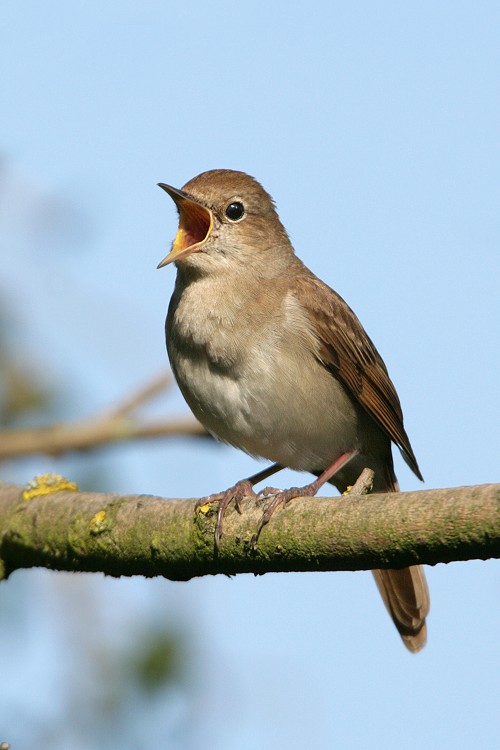Alternative names: Rufous Nightingale; Western Nightingale
- Luscinia megarhynchos
Identification
A grey-brown chat (16 - 17cm)
- Warm brown above
- Rusty-brown tail and rump
- Whitish below with sandy-buff breast and flanks
- Prominent large black eye with pale narrow eyering
- Indistinctive grey supercilium
Similar Species
The warm colour and the rusty-red tail are good fieldmarks to distinguish from the similar Thrush Nightingale3. However both species are easily told apart by song.
Distribution
Breeds in southern England and from Iberia and France east to central Poland, Hungary, the Balkans and Greece, also in the Ukraine, Caucasus and northern Turkey, and parts of the Middle East. Breeds on most larger Mediterranean islands and the coastal strip of North-West Africa. First breeding for Malta was in 1995.
The breeding range extends outside Europe into Iran, Kazakhstan, Mongolia, China and Afghanistan2.
Migratory, leaving breeding areas in late July-early October and passing through the southern half of the Region to winter in sub-Saharan Africa and returning from early April-mid May.
Vagrant to Iceland and Ireland, Norway, Sweden, Finland and Nepal.
Taxonomy
Like all species of the genus Luscinia it was formerly placed in the thrush Familiy Turdidae.
Subspecies
Clements1 accepts three subspecies:
- L. m. megarhynchos found in north-western Africa, Europe to central Turkey and the eastern Mediterranean
- L. m. africana found in the Caucasus, eastern Turkey and to Iran
- L. m. golzii from eastern Iran to Kazakhstan, Mongolia, China and Afghanistan (formerly hafizi)
The races differ only slightly in colour and size. They are not always separable.
Habitat
The habitat is varying through the range of this species. In W and N Europe it prefers open woodland with thickets, usually near water. In S Europe also dry maquis, edges of broadleaf forest without water or pinewoods with rich undergrowth are taken.2
Behaviour
Diet
The diet includes insects.
Vocalisation
The male sings at night.
References
- Clements, J. F., P. C. Rasmussen, T. S. Schulenberg, M. J. Iliff, T. A. Fredericks, J. A. Gerbracht, D. Lepage, A. Spencer, S. M. Billerman, B. L. Sullivan, M. Smith, and C. L. Wood. 2024. The eBird/Clements checklist of Birds of the World: v2024. Downloaded from https://www.birds.cornell.edu/clementschecklist/download/
- Del Hoyo, J, A Elliot, and D Christie, eds. 2005. Handbook of the Birds of the World. Volume 10: Cuckoo-Shrikes to Thrushes. Barcelona: Lynx Edicions. ISBN 978-8487334726
- Jonsson, L. 1992. Birds of Europe. London: Christopher Helm. ISBN 0-7136-5238-1
External Links
GSearch checked for 2020 platform.1






